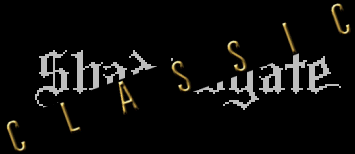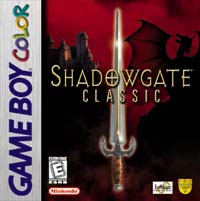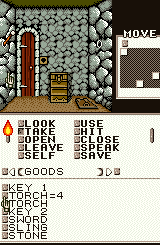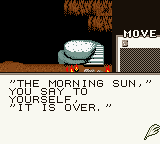 I have some bad news for everyone: That great dinosaur, the adventure game, has recently passed away. Only a small group of people even realized it, and even fewer missed its death. The genre has long been replaced by a very large set of games all put under the category of "RPG", which includes everything from boring 3d strategy games to Quake clones with the occasional text balloon. And as for the hard-core adventure games of "old" (ie. pre-Simpsons)? They're "classics", don't you know, and they're ripe for rerelease. Put out on the chopping block last week was Shadowgate Classic, the update of the computer and NES.. um.. classic.
Combine this situation with that of the Game Boy Color, a new system with nothing but re-releases and lame-o movie licenses to its name (the Game Boy seems to be the graveyard of bad licenses - Navy Seals in the past, A Bug's Life in the present, Rugrats in the future). The rumor spread that the GBC was NES compatible; while this was pretty untrue Nintendo has announced a slew of new GBC efforts ported from the NES. This is the first shot; Super Mario Bros. is announced and coming soon. The game
The main obstacle to porting NES games over to kids' waiting hands is the obvious - the screen's a hundred pixels or so smaller all around, making straight ports impossible. Kemco got around this problem by dividing the game's engine into two screens. The one you'll be looking at mostly has your first-person view of the current room, the "Move" grid and the first two rows of commands. You need to move the pointer down to view the rest of the entries and your inventory. This is a wee bit inconvenient but isn't worth getting worked up about... in fact, inventory management is actually a little quicker compared with the NES version as you can move around with the control pad as opposed
Slightly more annoying is the way that messages pop up on a special window, obscuring the graphic view. There was no real way around this, but it's still a bother when you can't see what's killing you because there's the text describing your valiant death in the way. As this is a straight port, nothing that you hated about the old NES game is improved here. Like I said, this game was popular in the late 80s, a time when logical solutions to adventure-game puzzles was considered optional and clues were either too cryptic or too obvious. You face several different monsters and they must all be killed in their own special way. You can't kill the bridge-guarding troll with a sword or sling or hammer or shovel or arrow - no, you have to throw the spear at him to drive him off. Clues range from the obvious riddle-rific scrolls to things like you finding a staff with a snake carving on it then finding a snake later on that happens to die when you wield it. So if you bang your head against the game for a little while (or if you use the walkthrough for the old game) you'll probably finish the game in little time and wonder what you spent your $29.99 on. The game is a little short by modern standards, which probably makes it all the more appropriate for the portable player who wants something to think about when he's not playing the GBC.
One of the things that bothered me about Shadowgate Classic as I played it was its size. While the NES Shadowgate was 256k, the GBC port takes up an entire megabyte worth of ROM. Sheesh! Has code bloat gotten that bad? I still find it a bit strange, but now I see what takes up the space: one, all the translated text; two, the two sets of graphics. Two? Yes, there are two screens for every location in the game; one for regular Game Boy users and one for GBC players. The new color screens take full advantage of the GBC's 32,000-color palette, the first color game I've seen to do so. The game is noticeably more colorful than the somewhat drab NES graphics (I think this is more a fault of Kemco than of the NES' capabilities) and many of the enemy monsters and backdrops look a lot better than the original and indeed the computer releases themselves. Some look completely redrawn from the original and some look like quick portovers; you can see some more examples separately. The B&W screens are more obviously based on the NES shots, however. Given the lack of color on the original graphics, they were probably easy to port over to the 4 shades of grey of the GB. The music and SFX are for the most part exactly the same as you heard on ze NES. Which is great in my book as I didn't realize that the GB was capable of producing the Kemco deep lead bass that prevailed in all its games. It'll rock your ears, man. Most of it, anyway, is spooky and fun to hear, except for that one tune in the middle of the game that sounds like it came from Speed Racer. Also, the aural moment I enjoyed the most - thunder cracking and then the best music in the game starting up - is destroyed here as SFX and music are played all at once. This means that the sounds of the horn and flute are muddled in the music, unfortunately. They should have fixed that in beta. In the end In the end, I doubt people really care too much about this. Nintendo needed it to boost its GBC release list at the start, and they've not bothered to advertise it on their TV ads. Kemco might sell a few more N64 "RPGs" because of this, but it'll soon be forgotten as everyone buys GBC Disney's Tarzan or whatever. Because let's face it - one, the adventure system is outdated and unwieldy by modern standards (the "Speak" command is only used for spells, and "Use" works too, so there's no need for the former), the game is a little short, and if you're reading this you've probably already played it. If you have a GBC, go play Warioland II instead - keep the 8-bit spirit alive and well and not buried in the past. Wait a few months and buy this used if you insist. The graphics are nice, but it ain't worth full price. E for effort on the graphics, anyway. |





